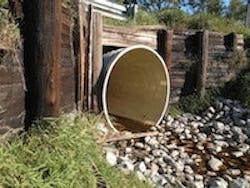Cured in Place Pipe Makes In-Roads in Culvert Rehabilitation
Layne Inliner’s cured in place pipe (CIPP) division has been restoring pipelines since 1991. As one of the largest CIPP providers in the United States, Layne has successfully rehabilitated more than 16 million ft of 4- to 90-in. pipeline of varying shapes and lengths. The products, which originated for wastewater systems, have progressed into industrial process sewers and more recently storm water culverts.
Storm water culverts can present some unique challenges. The most pressing issue often is the culvert location under major roadways and heavily travelled streets. For both economic and social reasons, local communities and state departments of transportation (DOTs) are not willing to disrupt service on these major roadways.
Capacity of culverts also tends to be an issue. As urban sprawl and development continues, culverts are being taxed with additional runoff. Capacity limits are being pushed and other rehabilitation methods that might reduce capacity are often not an option.
To further complicate this issue, many culverts are constructed of corrugated metal pipe (CMP). While the CMP can provide an economical solution when originally constructed, some inverts, especially those in earlier version pipes, can degrade over time particularly in areas where acidic soils or roadway chemicals used in winter months attack the metal. In fact, most culverts marked for rehabilitation have missing sections or no invert at all. Combine the degradation with the fact that many of these culverts are odd shaped, be it elliptical or arch, and the rehabilitation becomes even more complicated.
Past rehabilitative efforts were most often accomplished through excavation and replacement means or through traditional slip lining, a process in which a smaller diameter, round pipe is inserted into the old culvert pipe and the annual space then grouted. While these two methods can work, DOTs and local communities have discovered that CIPP can provide them with something better suited for these situations.
The CIPP Solution
CIPP is a process in which a resin-saturated tube is inserted into the deteriorated pipe, expanded to fit tight against the old pipe and then cured typically via hot water, steam or ultraviolet light. The end result is a new pipe within the old pipe possessing a minimum restored service life of 50 years. The decision to utilize CIPP hinges around the benefits it can provide including but not limited to:
- • Full structural renewal capabilities; the load bearing capacity of the culvert can be restored and even enhanced;
- • Quick installations;
- • Minimal internal diameter reduction;
- • Improved hydraulics; in most instances increased pipe carrying capacity;
- • Ability to rehabilitate not only circular but also elliptical, arch, odd shaped and non-uniform pipes;
- • Limited or even no traffic or social disruption; and
- • Economic cost.
Layne Inliner LLC with their Inliner CIPP has been rehabilitating culverts in Texas, Alabama, Indiana, Ohio, Michigan, Georgia and several other states. There have been hundreds of successful installations ranging from 12 inches to 90 inches in diameter and varying in shape from traditional round to elliptical and arch pipe. These installations have been made in class-one dams, in state parks, under multiple lane roads and highways, under buildings, through beautifully landscaped home sites, under golf courses, and along residential streets. Obstacles like missing inverts, internal bends and site related access issues have been overcome with proper planning and up front efforts. New tube technologies and “environmentally friendly” resins have been utilized in certain instances and continued developments in design and installation techniques have made what was once not even considered now feasible.
“CIPP is an excellent way to rehabilitate sanitary, stormwater and industrial process infrastructure. Its flexibility allows for cost effective and efficient system rehabilitation. If you have not yet seen it in your rehabilitation program, you are missing out on a viable technology.” said Denise McClanahan, vice president for Layne Inliner.
Mike Green is director of business development for Layne Inliner. Green can be reached at [email protected] or 502.585.1241.
